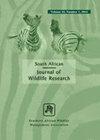The Changing Sizes of Critically Endangered White-Backed Vulture Breeding Colonies Around Kimberley, South Africa
引用次数: 6
Abstract
INTRODUCTION The White-backed Vulture (Gyps africanus; WbV) is critically endangered (BirdLife International 2017) and has declined by up to 90% across parts of its range over the last 30 years (Ogada et al. 2016). It is a tree-nesting species that tends to congregate in groups for breeding (Mundy, Butchart, Ledger & Piper 1992) and aerial surveys of these breeding areas offer a reliable and repeatable means of assessing local population changes (Howells & Hustler 1984) that can complement results from road transect surveys (Herremans & Herremans-Tonnoeyr 2000). Near Kimberley in central South Africa, breeding WbVs have been at least partially monitored since the 1960s (Forrester 1967). The only aerial survey of this population in 2001 yielded an estimated breeding population of 240 pairs (Murn, Anderson & Anthony 2002) across six colonies. The 2001 estimate was more than double the previous estimate of 110 pairs (Anderson & Maritz 1997); at that time, the breeding colonies at Kimberley represented nearly 7% of the national population estimate of 3500 pairs (Anderson 2000). Since 2001, however, the population status of all the breeding colonies of WbVs near Kimberley is unknown. There are no published studies that describe trends longer than 10 years for WbV populations in South Africa. Numbers of breeding WbVs appear to have declined in some areas (Murn et al. 2013) but increased in others (Hitchins 1980; Bamford et al. 2009). Thus, there is a need for long-term (>10 years) data to assess population trends of endangered vultures. Here we present results from aerial surveys of the WbV breeding colonies at Kimberley in 2014 and compare the results to those from 2001.南非金伯利周围极度濒危的白背秃鹫繁殖地的大小变化
引言白背秃鹫(Gyps africanus;WbV)处于极度濒危状态(国际鸟盟2017),在过去30年中,其部分活动范围内的数量下降了90%(Ogada等人,2016)。它是一种树木筑巢物种,倾向于聚集在一起进行繁殖(Mundy,Butchart,Ledger&Piper 1992),对这些繁殖区的空中调查提供了一种可靠且可重复的方法来评估当地种群变化(Howells&Hustler 1984),这可以补充道路横断面调查的结果(Herremans&Herremans Tonnoeyr 2000)。在南非中部的金伯利附近,自20世纪60年代以来,WbV的繁殖至少受到了部分监测(Forrester 1967)。2001年对该种群进行的唯一一次空中调查估计,在六个群落中有240对繁殖种群(Murn,Anderson和Anthony,2002年)。2001年的估计是之前估计的110对的两倍多(Anderson&Maritz,1997);当时,金伯利的繁殖地占全国3500对种群估计数的近7%(Anderson 2000)。然而,自2001年以来,金伯利附近所有WbV繁殖群体的种群状况尚不清楚。没有发表的研究描述南非WbV人群超过10年的趋势。繁殖WbV的数量在一些地区似乎有所下降(Murn等人,2013),但在其他地区有所增加(Hitchins 1980;Bamford等人,2009)。因此,需要长期(>10年)数据来评估濒危秃鹫的种群趋势。在这里,我们展示了2014年对金伯利WbV繁殖地的空中调查结果,并将其与2001年的结果进行了比较。
本文章由计算机程序翻译,如有差异,请以英文原文为准。
求助全文
约1分钟内获得全文
求助全文

 求助内容:
求助内容: 应助结果提醒方式:
应助结果提醒方式:


